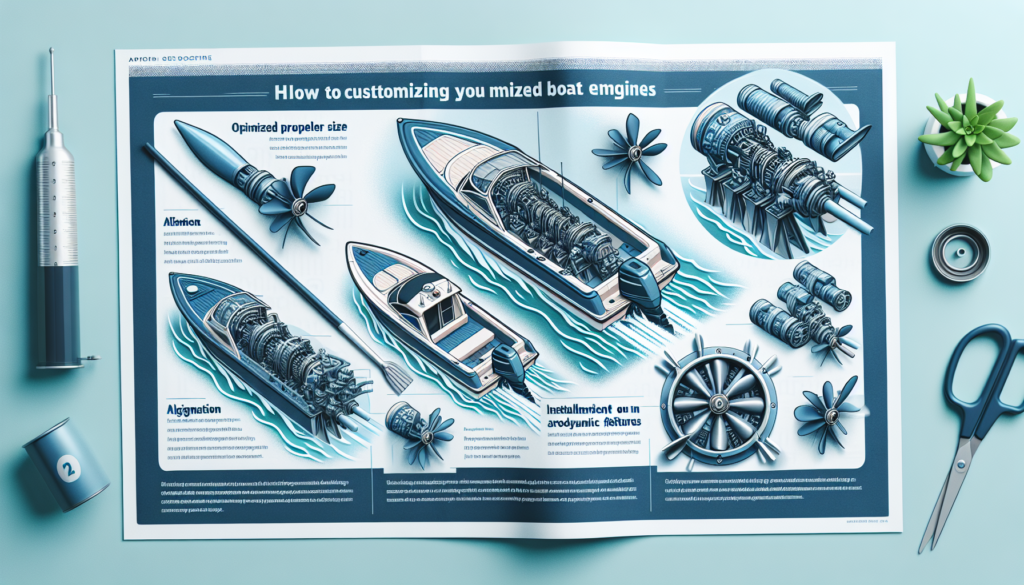You’ve always loved spending long hours out on the water, but lately, you can’t help but notice the increasing fuel costs when you take your boat out for a ride. If only there was a way to make your boat more fuel-efficient without sacrificing its performance. Well, you’ll be happy to know that there is! By customizing your boat engine, you can significantly increase its fuel efficiency while still enjoying all the joys of being out on the open sea. In this article, we will explore some amazing tips and tricks to help you achieve this, making your boating adventures more affordable and eco-friendly. Get ready to cruise the waves without breaking the bank!
Choosing the Right Boat Engine
Consider the Boat Size and Weight
When choosing a boat engine, it’s important to consider the size and weight of your boat. Different boat sizes and weights require different engine powers to ensure optimal performance. A larger and heavier boat will typically require a more powerful engine to provide enough thrust and speed. On the other hand, a smaller and lighter boat may not require as much power, which can help conserve fuel. By carefully considering your boat’s size and weight, you can choose the right engine that provides the perfect balance of performance and fuel efficiency.
Evaluate the Type of Usage
Another crucial factor to consider when choosing a boat engine is the type of usage you have in mind. Will you be using your boat for fishing, recreational cruising, or water sports? Each type of usage requires a different level of power and performance. For example, if you’ll be engaging in water sports like wakeboarding or tubing, you’ll need an engine with higher horsepower to provide the necessary thrust. On the other hand, if you’ll be using your boat mainly for leisurely cruises, a less powerful engine might be more suitable. Evaluating your specific usage requirements will help you find an engine that matches your needs while maximizing fuel efficiency.
Assess the Power Needs
Assessing the power needs of your boat is essential to ensure optimal engine performance. This involves considering factors such as the boat’s speed requirements and the type of water you’ll be navigating. If you primarily use your boat in calm waters, a less powerful engine may be sufficient. However, if you plan to venture into rougher waters or if you require higher speeds, a more powerful engine will be necessary. By accurately assessing the power needs of your boat, you can choose an engine that strikes the right balance between performance and fuel efficiency.
Optimizing Engine Performance
Maintain Proper Engine Tuning
Maintaining proper engine tuning is crucial for optimizing performance and fuel efficiency. Regularly tuning your boat’s engine ensures that it operates at its peak capabilities, minimizing fuel wastage and maximizing power. This involves checking and adjusting the ignition timing, idle speed, and fuel-to-air ratio. By following the manufacturer’s recommended tuning procedures or seeking professional assistance, you can keep your engine running smoothly and efficiently.
Utilize High-Quality Fuel and Additives
Using high-quality fuel and additives is another way to optimize your boat engine’s performance. Low-quality or contaminated fuel can lead to engine issues and decreased fuel efficiency. On the other hand, using fuel that meets the manufacturer’s recommended specifications can greatly enhance performance. Additionally, adding fuel additives specifically designed for marine engines can help clean fuel injectors, prevent fuel system deposits, and improve combustion efficiency. This can result in better fuel economy and overall engine performance.
Upgrade to Fuel Injection
Consider upgrading your boat’s engine to one with fuel injection technology. Fuel injection systems deliver fuel directly to the engine’s combustion chamber, providing precise control over the amount of fuel injected. This ensures efficient combustion and reduces fuel wastage. Compared to carbureted engines, fuel-injected engines are generally more fuel-efficient and offer better throttle response. While upgrading to a fuel-injected engine may involve some initial investment, the long-term benefits in terms of fuel savings and improved performance make it a worthwhile consideration.
Replace or Clean Air Filters Regularly
Regularly replacing or cleaning your boat’s air filters is vital for maintaining optimal engine performance. Air filters prevent dust, debris, and other contaminants from entering the engine, ensuring clean and efficient air intake. Over time, air filters can become clogged, leading to restricted airflow and decreased fuel efficiency. By following the manufacturer’s recommended replacement intervals or cleaning procedures, you can ensure that your boat’s engine receives a steady supply of clean air, resulting in improved fuel economy and overall performance.

Enhancing Propeller Efficiency
Select an Appropriate Propeller Size and Pitch
The propeller plays a crucial role in a boat’s performance and fuel efficiency. Selecting the appropriate propeller size and pitch for your boat is essential. A propeller that is too large or has too high of a pitch can cause the engine to work harder, resulting in increased fuel consumption. On the other hand, a propeller that is too small or has too low of a pitch may not allow the engine to reach its optimal RPM range, also affecting fuel economy. By consulting with a knowledgeable professional or referring to the manufacturer’s guidelines, you can choose a propeller that matches your boat’s specifications and maximizes fuel efficiency.
Consider the Material and Design
The material and design of the propeller can also impact performance and fuel efficiency. Propellers are commonly made from aluminum or stainless steel. Aluminum propellers are generally less expensive, but they may bend or wear out more quickly. Stainless steel propellers, on the other hand, are more durable and offer better performance, but they come at a higher cost. Additionally, consider the design of the propeller blades. Different blade designs, such as three-blade or four-blade propellers, can provide different levels of performance and fuel efficiency. It’s important to evaluate these factors and choose a propeller that aligns with your specific needs and budget.
Ensure Proper Propeller Balance
Maintaining proper propeller balance is crucial for optimal performance and fuel efficiency. An unbalanced propeller can cause vibrations, which not only affects the comfort of your ride but also reduces fuel efficiency. Vibrations can cause the engine to work harder and consume more fuel. Regularly inspecting and balancing your boat’s propeller ensures smooth operation and maximizes fuel savings. If you notice any vibrations or suspect an imbalance, it’s important to address the issue promptly by consulting with a professional propeller service technician.
Regularly Inspect and Repair Damaged Propellers
Regularly inspecting and repairing any damage to your boat’s propellers is essential for maintaining efficiency. Damaged propellers, such as bent or dented blades, can disrupt the smooth flow of water and negatively impact performance. Inefficient propeller operation can result in increased fuel consumption. Therefore, it’s important to regularly examine your propellers and promptly repair any damages. Small repairs can often be done yourself, but for more extensive damage, it’s recommended to seek professional assistance to ensure proper repairs and to maintain peak fuel efficiency.
Improving Hull and Boat Design
Reduce Drag with Hull Cleaning and Maintenance
Reducing drag is key to improving fuel efficiency on your boat. Drag is the resistance that the boat’s hull encounters as it moves through the water. Over time, the hull can accumulate algae, barnacles, and other marine growth, leading to increased drag and reduced fuel economy. Regularly cleaning and maintaining the hull helps minimize drag and maximize fuel efficiency. This can be done by scrubbing the hull and using specialized cleaning solutions to remove any buildup. By keeping your hull clean and well-maintained, you can ensure smooth movement through the water and improve fuel efficiency.
Consider Hydrodynamic Enhancements
Implementing hydrodynamic enhancements can further improve fuel efficiency by reducing drag. These enhancements can include the installation of devices such as foils, trim tabs, and hull extensions. Foils or hydrofoils can help lift the hull out of the water, reducing its drag. Trim tabs can be adjusted to fine-tune the boat’s balance and optimize performance. Hull extensions can increase the boat’s length, improving stability and reducing drag. By consulting with professionals or accessing resources from boat manufacturers, you can determine which hydrodynamic enhancements are suitable for your boat and can result in improved fuel economy.
Optimize Weight Distribution
Optimizing the weight distribution on your boat plays a significant role in fuel efficiency. An imbalanced weight distribution can negatively impact performance, causing the boat to consume more fuel. By distributing weight evenly throughout the boat and avoiding excessive weight towards the bow or stern, you can achieve better stability and reduce drag. This can result in improved fuel economy and a more comfortable boating experience. It’s important to consult your boat manufacturer’s guidelines or seek professional advice to ensure that you optimize weight distribution effectively.
Use Anti-fouling Paint to Prevent Barnacles and Algae
To prevent the accumulation of barnacles and algae on your boat’s hull, consider using anti-fouling paint. Anti-fouling paint contains biocides that prevent marine growth from attaching to the hull. By applying anti-fouling paint, you can significantly reduce drag and improve fuel efficiency. Additionally, anti-fouling paint helps protect the hull from corrosion and damage, prolonging its lifespan. When choosing an anti-fouling paint, ensure that it is suitable for your boat’s hull material and follow the manufacturer’s instructions for application and maintenance.

Reducing Parasitic Power Losses
Minimize Onboard Electrical Load
Minimizing the onboard electrical load is an effective way to reduce parasitic power losses and improve fuel efficiency. Running multiple electrical accessories simultaneously can place a strain on the boat’s electrical system and increase fuel consumption. To optimize fuel efficiency, avoid using unnecessary electrical equipment while on board. This includes turning off lights, electronics, and appliances when they are not in use. By actively managing your electrical load, you can maximize fuel economy and extend your boating range.
Opt for Energy-Efficient Accessories
When choosing accessories for your boat, opt for energy-efficient options. Energy-efficient accessories are designed to minimize power consumption, which directly translates to fuel savings. For example, consider using LED lights instead of traditional incandescent bulbs. LED lights consume less energy while providing the same level of brightness. Additionally, choosing energy-efficient appliances and electronics can further decrease the onboard electrical load and improve fuel efficiency. When purchasing new accessories, look for energy-efficient certifications or consult with professionals to select the most fuel-efficient options available.
Utilize LED Lighting
Utilizing LED lighting on your boat can significantly improve fuel efficiency. LED lights are highly energy-efficient, using significantly less power than traditional incandescent bulbs. This means less strain on your boat’s electrical system and reduced fuel consumption. LED lights also have a longer lifespan, reducing the need for frequent bulb replacements. By replacing your boat’s existing lights with LED alternatives, you can make a simple yet effective change that will contribute to improved fuel efficiency.
Inspect and Repair Seals, Hatches, and Gaskets
Regularly inspecting and repairing any damaged seals, hatches, and gaskets is crucial for reducing parasitic power losses. These components help maintain a watertight and airtight seal, preventing water and air leakage. Damaged or worn seals, hatches, or gaskets can result in increased drag and reduced fuel efficiency. By performing routine inspections and promptly addressing any issues, you can ensure that your boat remains properly sealed, minimizing parasitic power losses and maximizing fuel economy.
Implementing Fuel Monitoring and Management
Install a Fuel Flow Meter
Installing a fuel flow meter on your boat allows for accurate monitoring of fuel consumption. A fuel flow meter measures the rate of fuel consumption in real-time, providing you with valuable data to optimize fuel management. By continuously monitoring fuel flow, you can make informed decisions about your boating habits and adjust your speed and throttle accordingly. This helps minimize fuel wastage and maximizes fuel efficiency.
Track Fuel Consumption and Performance
Tracking fuel consumption and performance is key to effective fuel management. Keep a record of the amount of fuel consumed during each boating trip, along with other relevant variables such as the distance traveled and the speed maintained. These records can help you identify patterns and make adjustments to optimize fuel efficiency. By closely monitoring your boat’s fuel consumption and performance, you can make informed decisions about your boating habits and identify areas where fuel efficiency can be improved.
Use a Trim Gauge for Optimal Trim Level
Using a trim gauge can help you achieve optimal trim level, which contributes to improved fuel efficiency. The trim level refers to the tilt angle of the engine in relation to the boat’s hull. An improperly trimmed boat can cause drag and result in increased fuel consumption. By using a trim gauge to adjust the tilt angle of the engine, you can find the optimal position that minimizes drag and maximizes fuel efficiency. It’s important to consult your boat manufacturer’s guidelines or seek professional advice to ensure that you achieve the correct trim level.
Employ Fuel-Management Systems
Fuel-management systems offer advanced features for optimizing fuel efficiency. These systems integrate various components such as fuel flow meters, GPS, and engine data, providing comprehensive real-time information about your boat’s fuel consumption and performance. Some fuel-management systems can even provide recommendations on optimizing throttle settings based on real-time conditions, helping you make immediate adjustments for fuel savings. By employing a fuel-management system, you can take advantage of sophisticated technology to enhance your boat’s fuel efficiency.

Adopting Fuel-Saving Boating Techniques
Maintain Steady Speed and Avoid Quick Accelerations
Maintaining a steady speed and avoiding quick accelerations is a simple yet effective technique for saving fuel. Rapid acceleration requires the engine to work harder and consume more fuel. By gradually increasing your boat’s speed and maintaining a constant pace, you can reduce fuel consumption while still enjoying a pleasant boating experience. Additionally, maintaining a steady speed helps reduce hull drag and further contributes to improved fuel efficiency. By adopting this mindful boating technique, you can reduce fuel costs and enhance your overall fuel efficiency.
Avoid Overloading the Boat
Avoiding overloading your boat is crucial for optimal fuel efficiency. Overloading places excessive strain on the engine, making it work harder and consume more fuel. By ensuring that your boat’s weight remains within its recommended capacity, you can prevent unnecessary fuel wastage. Additionally, overloading can affect the boat’s stability and increase drag, further impacting fuel efficiency. To enjoy a safe and fuel-efficient boating experience, always adhere to the manufacturer’s guidelines regarding the maximum weight capacity of your boat.
Utilize Trim Tabs Effectively
Utilizing trim tabs effectively can significantly contribute to fuel savings. Trim tabs are adjustable surfaces located on the rear of the boat that can be adjusted up or down to fine-tune the boat’s balance and improve performance. By adjusting the trim tabs, you can optimize the boat’s attitude in the water, minimizing drag and reducing fuel consumption. It’s important to understand how to use trim tabs properly and consult your boat manufacturer’s guidelines or seek professional advice to ensure that you achieve the desired results.
Consider Tidal Currents and Wind Direction
Considering tidal currents and wind direction is essential for fuel-efficient boating. Tidal currents can either assist or hinder your boat’s progress, depending on their direction and strength. By timing your trips to coincide with favorable tidal currents, you can harness their power and reduce fuel consumption. Additionally, taking wind direction into account can provide opportunities for more efficient sailing. By utilizing the wind’s natural propulsion, you can reduce reliance on your boat’s engine and save fuel. Awareness of these environmental factors and strategic planning can contribute to significant fuel savings.
Regular Engine Maintenance
Follow Manufacturer’s Maintenance Schedule
Following the manufacturer’s maintenance schedule is crucial for keeping your boat’s engine in top condition. Regular maintenance ensures that all components are functioning properly, minimizing the risk of unexpected breakdowns and optimizing fuel efficiency. The maintenance schedule provided by the manufacturer outlines specific intervals for tasks such as oil changes, filter replacements, and inspections. By adhering to this schedule and performing routine maintenance tasks, you can extend the life of your engine, maximize fuel efficiency, and enjoy worry-free boating experiences.
Perform Regular Oil Changes
Regular oil changes are vital for maintaining an efficient and reliable engine. Oil lubricates the engine’s moving parts, reducing friction and heat. Over time, oil can become contaminated with dirt, water, and combustion by-products, impairing its lubrication properties. Regularly changing the engine oil ensures that it remains clean and effective in protecting the engine. Fresh oil helps reduce friction and heat buildup, which can result in improved fuel efficiency. Consult your boat manufacturer’s recommendations or seek professional advice to determine the appropriate oil change intervals for your engine.
Inspect Fuel Systems for Leaks
Regularly inspecting your boat’s fuel systems for leaks is essential for safety and fuel efficiency. Fuel leaks not only pose a fire hazard but can also result in increased fuel consumption. A leaky fuel system allows fuel to escape before it reaches the engine, leading to wasted fuel and reduced efficiency. By visually inspecting fuel lines, fittings, and connections for any signs of leaks and promptly addressing them, you can prevent fuel wastage and ensure that your boat’s engine receives the fuel it needs to operate optimally.
Check and Adjust Drive Belt Tension
Checking and adjusting the drive belt tension is an important part of engine maintenance. The drive belt connects the engine’s crankshaft to various components, such as the alternator and water pump. Over time, the drive belt can stretch or become worn, affecting its tension and performance. An improperly tensioned drive belt can cause the engine to work harder, reducing fuel efficiency. By regularly checking the drive belt tension and making adjustments as necessary, you can ensure that the belt operates optimally, reducing strain on the engine and maximizing fuel economy.

Monitoring and Analyzing Performance
Use Fuel Consumption Apps and Trackers
Using fuel consumption apps and trackers can provide valuable insights into your boat’s performance and fuel efficiency. These apps and trackers allow you to record and monitor fuel consumption, distance traveled, and other variables in real-time. By inputting data such as fuel purchases and boat specifications, you can track your fuel usage and identify trends or patterns. This data can help you make informed decisions about your boating habits and identify areas where fuel efficiency can be improved. By leveraging technology and utilizing these tools, you can further optimize your boat’s fuel efficiency.
Record Boat Speed and RPM Data
Recording boat speed and RPM data is essential for analyzing and monitoring performance. Boat speed and RPM (revolutions per minute) data provide valuable information about the engine’s workload and efficiency. By tracking boat speed and RPM under various conditions, you can identify the most fuel-efficient operating range for your engine. This data can help you make adjustments to your boating habits and optimize fuel efficiency. Record this information during your boating trips and refer to it during analysis sessions to understand how various factors affect your boat’s fuel consumption.
Analyze and Interpret Performance Data
Analyzing and interpreting performance data is crucial for understanding your boat’s fuel efficiency and identifying areas for improvement. Once you have collected data on fuel consumption, boat speed, and RPM, you can analyze the information to identify correlations and patterns. By examining how different factors, such as speed, weather conditions, or trim settings, impact fuel efficiency, you can make informed decisions to optimize your boating experience. Look for trends, anomalies, or areas where improvement is needed, and use this information to make adjustments to your boating habits and setup.
Make Adjustments Based on Analysis
Making adjustments based on the analysis of performance data is the final step in optimizing fuel efficiency. Once you have analyzed the data collected during your boating trips and identified areas for improvement, it’s important to make appropriate adjustments. This may involve modifying your boating habits, adjusting trim settings, or optimizing your boat’s setup. By implementing the changes suggested by the analysis, you can further enhance fuel efficiency and enjoy a more cost-effective and environmentally friendly boating experience.
Seeking Professional Expertise
Consult with Boat Manufacturers or Dealers
Consulting with boat manufacturers or dealers is a valuable resource for optimizing fuel efficiency. Manufacturers and dealers possess in-depth knowledge and expertise about boat engines and their specific models. They can provide guidance on choosing the right engine for your boat, offer maintenance recommendations, and answer any questions you may have. By seeking their expertise, you can gain valuable insights into how to maximize fuel efficiency and ensure that your boat performs at its best.
Hire Certified Marine Technicians
Hiring certified marine technicians is highly recommended for comprehensive engine maintenance and repairs. Certified technicians undergo training and possess the necessary skills and knowledge to service boat engines effectively. They can perform tasks such as engine tuning, oil changes, fuel system inspections, and other maintenance procedures. By hiring certified technicians, you can ensure that your boat’s engine receives professional care and attention, ultimately improving fuel efficiency and extending the engine’s lifespan.
Join Boating Clubs or Online Communities
Joining boating clubs or online communities provides opportunities to connect with fellow boaters and exchange valuable insights and experiences. These communities often consist of knowledgeable and experienced boaters who can offer tips and advice on optimizing fuel efficiency. By engaging with these communities, you can learn from others’ experiences, share your own knowledge, and stay up to date with the latest advancements in fuel-saving techniques and technologies. Participating in boating clubs or online communities can provide a valuable support network and a wealth of information to help you enhance your fuel efficiency.
Participate in Boating Training Programs
Participating in boating training programs can offer valuable education and hands-on experience to improve fuel efficiency. Training programs provide guidance on proper operation, maintenance, and safety procedures for boat owners. By enrolling in these programs, you can learn best practices directly from experienced instructors and gain practical skills that can optimize your boat’s fuel efficiency. Whether you are a new boat owner or an experienced boater looking to enhance your skills, participating in boating training programs can be a valuable investment that pays off in increased fuel savings and improved overall boating experience.
In conclusion, increasing fuel efficiency with boat engine customization involves several factors and considerations. By choosing the right boat engine based on boat size, weight, usage, and power needs, you can optimize performance and fuel efficiency. Enhancing propeller efficiency through selecting the appropriate propeller size and pitch, considering materials and design, ensuring proper balance, and maintaining propellers in good condition can further contribute to improved fuel economy. Improving hull and boat design by reducing drag, considering hydrodynamic enhancements, optimizing weight distribution, and using anti-fouling paint can also enhance fuel efficiency. Additionally, reducing parasitic power losses through minimizing onboard electrical load, opting for energy-efficient accessories, utilizing LED lighting, and inspecting and repairing seals, hatches, and gaskets is crucial. Implementing fuel monitoring and management systems, adopting fuel-saving boating techniques, performing regular engine maintenance, monitoring and analyzing performance data, and seeking professional expertise are all important steps in increasing fuel efficiency with boat engine customization. By implementing these strategies and practices, you can maximize fuel savings, minimize environmental impact, and enjoy an optimized boating experience.


